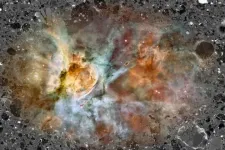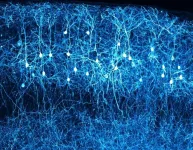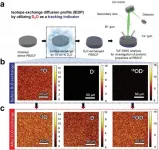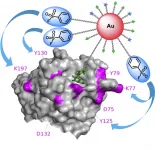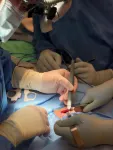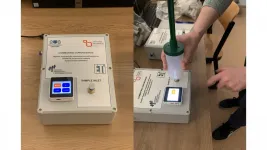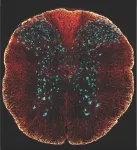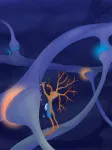(Press-News.org) In 2011, scientists confirmed a suspicion: There was a split in the local cosmos. Samples of the solar wind brought back to Earth by the Genesis mission definitively determined oxygen isotopes in the sun differ from those found on Earth, the moon and the other planets and satellites in the solar system.
Early in the solar system's history, material that would later coalesce into planets had been hit with a hefty dose of ultraviolet light, which can explain this difference. Where did it come from? Two theories emerged: Either the ultraviolet light came from our then-young sun, or it came from a large nearby star in the sun's stellar nursery.
Now, researchers from the lab of Ryan Ogliore, assistant professor of physics in Arts & Sciences at Washington University in St. Louis, have determined which was responsible for the split. It was most likely light from a long-dead massive star that left this impression on the rocky bodies of the solar system. The study was led by Lionel Vacher, a postdoctoral research associate in the physics department's Laboratory for Space Sciences.
Their results are published in the journal Geochimica et Cosmochimica Acta.
"We knew that we were born of stardust: that is, dust created by other stars in our galactic neighborhood were part of the building blocks of the solar system," Ogliore said.
"But this study showed that starlight had a profound effect on our origins as well."
*Tiny time capsule
All of that profundity was packed into a mere 85 grams of rock, a piece of an asteroid found as a meteorite in Algeria in 1990, named Acfer 094. Asteroids and planets formed from the same presolar material, but they've been influenced by different natural processes. The rocky building blocks that coalesced to form asteroids and planets were broken up and battered; vaporized and recombined; and compressed and heated. But the asteroid that Acfer 094 came from managed to survive for 4.6 billion years mostly unscathed.
"This is one of the most primitive meteorites in our collection," Vacher said. "It was not heated significantly. It contains porous regions and tiny grains that formed around other stars. It is a reliable witness to the solar system's formation."
Acfer 094 is also the only meteorite that contains cosmic symplectite, an intergrowth of iron-oxide and iron-sulfide with extremely heavy oxygen isotopes -- a significant finding.
The sun contains about 6% more of the lightest oxygen isotope compared with the rest of the solar system. That can be explained by ultraviolet light shining on the solar system's building blocks, selectively breaking apart carbon monoxide gas into its constituent atoms. That process also creates a reservoir of much heavier oxygen isotopes. Until cosmic symplectite, however, no one had found this heavy isotope signature in samples of solar system materials.
With only three isotopes, however, simply finding the heavy oxygen isotopes wasn't enough to answer the question of the origin of the light. Different ultraviolet spectra could have created the same result.
"That's when Ryan came up with the idea of sulfur isotopes," Vacher said.
Sulfur's four isotopes would leave their marks in different ratios depending on the spectrum of ultraviolet light that irradiated hydrogen sulfide gas in the proto-solar system. A massive star and a young sun-like star have different ultraviolet spectra.
Cosmic symplectite formed when ices on the asteroid melted and reacted with small pieces of iron-nickel metal. In addition to oxygen, cosmic symplectite contains sulfur in iron sulfide. If its oxygen witnessed this ancient astrophysical process -- which led to the heavy oxygen isotopes -- perhaps its sulfur did, too.
"We developed a model," Ogliore said. "If I had a massive star, what isotope anomalies would be created? What about for a young, sun-like star? The precision of the model depends on the experimental data. Fortunately, other scientists have done great experiments on what happens to isotope ratios when hydrogen sulfide is irradiated by ultraviolet light."
Sulfur and oxygen isotope measurements of cosmic symplectite in Acfer 094 proved another challenge. The grains, tens of micrometers in size and a mixture of minerals, required new techniques on two different in-situ secondary-ion mass spectrometers: the NanoSIMS in the physics department (with assistance from Nan Liu, research assistant professor in physics) and the 7f-GEO in the Department of Earth and Planetary Sciences, also in Arts & Sciences.
*Putting the puzzle together
It helped to have friends in earth and planetary sciences, particularly David Fike, professor of earth and planetary sciences and director of Environmental Studies in Arts & Sciences, and Clive Jones, research scientist in earth and planetary sciences.
"They are experts in high-precision in-situ sulfur isotope measurements for biogeochemistry," Ogliore said. "Without this collaboration, we would not have achieved the precision we needed to differentiate between the young sun and massive star scenarios."
The sulfur isotope measurements of cosmic symplectite were consistent with ultraviolet irradiation from a massive star, but did not fit the UV spectrum from the young sun. The results give a unique perspective on the astrophysical environment of the sun's birth 4.6 billion years ago. Neighboring massive stars were likely close enough that their light affected the solar system's formation. Such a nearby massive star in the night sky would appear brighter than the full moon.
Today, we can look to the skies and see a similar origin story play out elsewhere in the galaxy.
"We see nascent planetary systems, called proplyds, in the Orion nebula that are being photoevaporated by ultraviolet light from nearby massive O and B stars," Vacher said.
"If the proplyds are too close to these stars, they can be torn apart, and planets never form. We now know our own solar system at its birth was close enough to be affected by the light of these stars," he said. "But thankfully, not too close."
INFORMATION:
The neocortex is a layered structure of the brain in which neurons are arranged parallel to each other. This organization is critical for healthy brain function. A team of researchers from Charité - Universitätsmedizin Berlin have uncovered two key processes that direct this organization. Reporting in Science Advances*, the researchers identify one crucial factor which ensures the timely movement of neurons into their destined layer and, subsequently, their final parallel orientation within this space.
The neocortex is the outer region of the brain. It is responsible for cognitive functions such as language, decision-making, and ...
A research team, led by Professor Guntae Kim in the School of Energy and Chemical Engineering at UNIST has introduced an innovative way to quantify proton kinetic properties of triple (H+/O2?/e?) conducting oxides (TCOs) being a significant indicator for characterizing the electrochemical behavior of proton and the mechanism of electrode reactions.
Layered perovskites have recently received much attention as they have been regarded as promising cathode materials for protonic ceramic fuel cells (PCFCs) that use proton conducting oxide (PCO) as an electrolyte. Therefore, quantitative characterization of the proton kinetics in TCO can be an important indicator providing a scientific ...
Psychologists from UNSW Sydney have developed a new face identification ability test that will help find facial recognition experts for a variety of police and government agencies, including contract tracing.
The Glasgow Face Matching Test 2 [GFMT2] targets high-performing facial recognition individuals known as super-recognisers, who have an extraordinary ability to memorise and recall faces.
The type of professional roles that involve face identification and that could benefit from the test include visa processors, passport issuers, border control officers, ...
Cells play a precise game of telephone, sending messages to each other that trigger actions further on. With clear signaling, the cells achieve their goals. In disease, however, the signals break up and result in confused messaging and unintended consequences. To help parse out these signals and how they function in health -- and go awry in disease -- scientists tag proteins with labels they can follow as the proteins interact with the molecular world around them.
The challenge is figuring out which proteins to label in the first place. Now, a team led by researchers from Tokyo University of Agriculture and Technology (TUAT) has developed a new approach to identifying and tagging the specific proteins. They published their results on June 1 in Angewandte ...
AUSTIN, Texas -- A diagnostic tool called the MasSpec Pen has been tested for the first time in pancreatic cancer patients during surgery. The device is shown to accurately identify tissues and surgical margins directly in patients and differentiate healthy and cancerous tissue from banked pancreas samples. At about 15 seconds per analysis, the method is more than 100 times as fast as the current gold standard diagnostic, Frozen Section Analysis. The ability to accurately identify margins between healthy and cancerous tissue in pancreatic cancer surgeries can give patients the greatest chance of survival.
The results, by a team from ...
TORONTO, July 6, 2021 - What's stressing out bumblebees? To find out, York University scientists used next-generation sequencing to look deep inside bumblebees for evidence of pesticide exposure, including neonicotinoids, as well as pathogens, and found both.
Using a conservation genomic approach - an emerging field of study that could radically change the way bee health is assessed - the researchers studied Bombus terricola or the yellow-banded bumblebee, a native to North America, in agricultural and non-agricultural areas. This new technique allows scientists to probe for invisible stressors affecting bees.
Like many pollinators, the yellow-banded bumblebee ...
A collaborative research project between the five First Nations of the Nanwakolas Council of B.C. and Simon Fraser University is contributing to conservation efforts of the iconic western redcedar tree.
New research in the Journal of Ethnobiology highlights concerns about the long-term sustainability of this culturally significant resource. Researchers found that western redcedar trees suitable for traditional carving are generally rare. Some important growth forms, such as large, spectacular trees appropriate for carving community canoes, are nearly extirpated from ...
WASHINGTON, July 6, 2021 -- Emitted as gases from certain solids or liquids, volatile organic compounds (VOCs) include a variety of chemicals. Many of these chemicals are associated with a range of adverse human health effects, from eye, nose, and throat irritation, to liver, kidney, and central nervous system damage.
The ability to detect VOCs in air samples simply, quickly, and reliably is valuable for several practical applications, from determining indoor air quality to screening patients for illnesses.
In Review of Scientific Instruments, by AIP ...
Mammals have a poor ability to recover after a spinal cord injury which can result in paralysis. A main reason for this is the formation of a complex scar associated with chronic inflammation that produces a cellular microenvironment that blocks tissue repair. Now, a research team led by Leonor Saude, group leader at Instituto de Medicina Molecular Joao Lobo Antunes (iMM; Portugal) and Professor at Faculdade de Medicina da Universidade de Lisboa, have shown that the administration of drugs that target specific cellular components of this scar, improve functional recovery after injury. The results now published in the scientific journal Cell Reports* set the basis for a new promising therapeutic strategy not ...
From the bark of a puppy to the patter of rain against the window, our brains receive countless signals every second. Most of the time, we tune out inconsequential cues--the buzz of a fly, the soft rustle of leaves in the tree--and pay attention to important ones--the sound of a car horn, a bang on the door. This allows us to function, navigate and, indeed, survive in the world around us.
The brain's remarkable ability to sift through this ceaseless flow of information is enabled by an intricate neural network made up of billions of synapses, specialized junctions that regulate signal transmission between and ...
